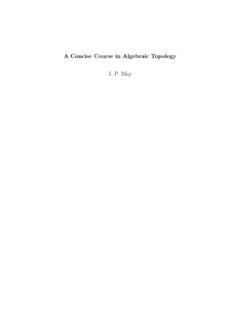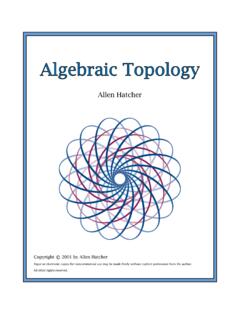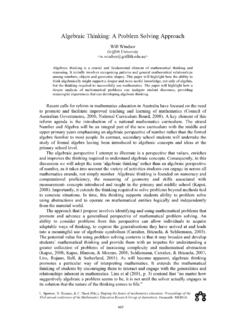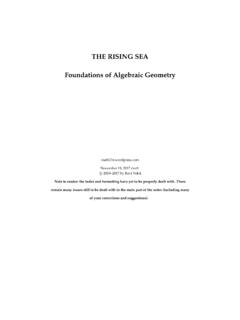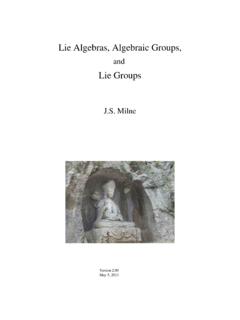Transcription of Introduction to Algebraic Geometry
1 Introduction toAlgebraicGeometryIntroduction toAlgebraicGeometrybyJustin R. SmithSecond EditionThis is dedicated to mywonderful wife, Brigitte. 2021. Justin R. Smith. All rights : 9798751789374 (Independently Published)Also by Justin R. Smith Eye of a Fly(Kindle edition). The God Virus(Kindle and paperback) Ohana(Kindle and paperback) The Accidental Empress(Kindle and paperback) Constance Fairchild Adventures (published by Silver Leaf Books): The Mills of God,hardcover. The Well of Souls,(Kindle edition and paperback).Justin Smith s home Algebraic Geometry seems to have acquired the reputation of beingesoteric, exclusive, and very abstract, with adherents who are secretlyplotting to take over all the rest of mathematics.
2 In one respect thislast point is accurate. David Mumford in [122].This book is intended for self-study or as a textbook for graduate studentsor advanced undergraduates. It presupposes some basic knowledge of point-set topology and a solid foundation in linear algebra. Otherwise, it developsall of the commutative algebra, sheaf-theory and cohomology needed to un-derstand the material. This is the kind of background students might have ata school that emphasizes applied mathematics, or one where enrollment is notsufficient to run separate courses in commutative first chapter is an Introduction to the Algebraic approach to solving aclassic geometric problem. It develops concepts that are useful and interestingon their own, like the Sylvester matrix and resultants of polynomials.
3 It con-cludes with a discussion of how problems in robots and computer vision canbe framed in Algebraic 2 on page 35 develops classical affine Algebraic Geometry , provid-ing a foundation for scheme theory and projective Geometry . it also developsthe theory of Gr bner bases and applications of them to the robotics problemsfrom the first 3 on page 117 studies the local properties of affine varieties material that is relevant for projective varieties as 4 on page 161 is an Introduction to the language of schemes andgeneral varieties. It attempts motivate these concepts by showing that certainnatural operations on varieties can lead to objects that are schemes but not 5 on page 219 covers projective varieties, using material from chap-ter 3 on open affines.
4 In the section on Grassmanians, it has a complete treat-ment of interior the section on intersection theory, it revisits the classical problem intro-duced in chapter 1 and provides a modern chapter 6, the book culminates with two proofs of the Riemann-Rochtheorem. The first is classical (Brill-Noether) and reasonably straightforward introducing some elegant geometric concepts and results. The second proofis the modern one using the heavy machinery of sheaf cohomology and SerreDuality. Both are included because they give an instructor flexibility in ap-proaching this subject. In particular, the sheaf cohomology of the second proofgives students a good idea of how the subject is done A on page 341 develops almost all of the commutative algebraneeded to understand the rest of the book (specialized material is provided asneeded): students are only required to have an understanding of linear algebraand the concept of a group.
5 Students with some commutative algebra can skipit and refer back to it as needed (page-references are used throughout the bookto facilitate this). It ends with a brief treatment of category B on page 495 is an Introduction to sheaves, in preparation forstructure sheaves of schemes and general varieties. It also develops the theoryof vector-bundles over an affine C on page 507 develops the topological concept of vector D on page 519 develops basic concepts of homological algebraand applies this to sheaves and rings. It culminates with a proof of the SerreDuality theorem. Sections marked with a dangerous bend symbol are more advanced and maybe skipped on a first to roughly half of the exercises are found at the end of the 1 and 2 (with a sidelong glance at appendix A) may be suitablefor a semester of an undergraduate course.
6 Appendix A has been used as thetext for the second semester of an abstract algebra 3 and 4 (or even chapter 5, skipping chapter 4) could make up thetext for a second am grateful to Patrick Clarke and Thomas Yu for many helpful and in-teresting discussions. Their insights and comments have improved this bookconsiderably. I am also grateful to people theircomments. The list includes (but is not limited to): Matthew Emerton, WillSwain, Nick Ramsey, and Angelo am indebted to Noel Robinson for pointing out a gap in the proof of corol-lary on page 111. Correcting it entailed adding the material oncatenaryringsin section on page 100. His questions also resulted in simpler and(hopefully) clearer proof of theorem on page am grateful to Darij Grinberg for his extremely careful reading of the man-uscript.
7 He identified several significant am also grateful to Matthias Ettrich and the many other developers of thesoftware, LYX a free front end to LATEX that has the ease of use of a wordprocessor, with spell-checking, an excellent equation editor, and a thesaurus. Ihave used this software for years and the current version is more polished andbug-free than most commercial is available of FiguresxiChapter 1. A classical B zout s The projective The Sylvester Application to B zout s The Mystic Robotics28 Chapter 2. Affine Hilbert s Computations in polynomial rings: Gr bner The coordinate specm Applications to optimization Dimension98 Chapter 3.
8 Local properties of affine The coordinate ring at a The tangent Normal varieties and finite Vector bundles on affine varieties154 Chapter 4. Varieties and Affine Subschemes and ringed Varieties and separated schemes205 Chapter 5. Projective Invertible sheaves on projective Regular and rational Noether Graded ideals and B zout s Theorem Divisors284 Chapter 6. Basic Elliptic The Riemann-Roch The modern approach to The Hurwitz-Riemann Thej-invariant337 Appendix A. Unique factorization Further topics in ring A glimpse of category Tensor Algebras and The module of K hler differentials482 Appendix B.
9 Sheaves and ringed Presheaves verses Ringed spaces502 Appendix C. Vector Vector-bundles and sheaves514 Appendix D. Chain complexes and Rings and Cohomology of Serre Duality561 Appendix E. Solutions to Selected Exercises575 Appendix. Glossary631 Appendix. Index635 Appendix. Bibliography643 List of A quadratic intersecting a Intersection of a quadratic and Two Intersection in example on page A factor of multiplicity 2 in example on page Perturbation of figure on page Intersection of multiplicity Intersection of multiplicity Intersection of a union of Hexagrammum Grouping the lines into two Another Pascal A simple robot A more complicated robot An elliptic Closure in the Zariski An intersection of multiplicity Reaching a Points reachable by the second robot Fibers of a regular Flat A rational function on a unit Parametrization of an
10 Rationalization of the Minimal prime ideal containing(x) s cone becomes the tangent space132xixiiLIST OF connected, reducible of a SpecZwith its generic A nilpotent Gluing affines, case Gluing affines, case Affine cone of an Blowing Blowing Shrinking an affine Minimal prime Topological genus Three points that sum to Relations between classes of trivial line-bundle over a a vector bundle by nontrivial line-bundle over a nontrivial bundle unrolled Perspective in projective Hyperbola projected onto a s Roman surface591 Introduction toAlgebraicGeometryCHAPTER 1A classical resultAwake! for Morning in the Bowl of NightHas flung the Stone that puts the Stars to Flight:And Lo!
